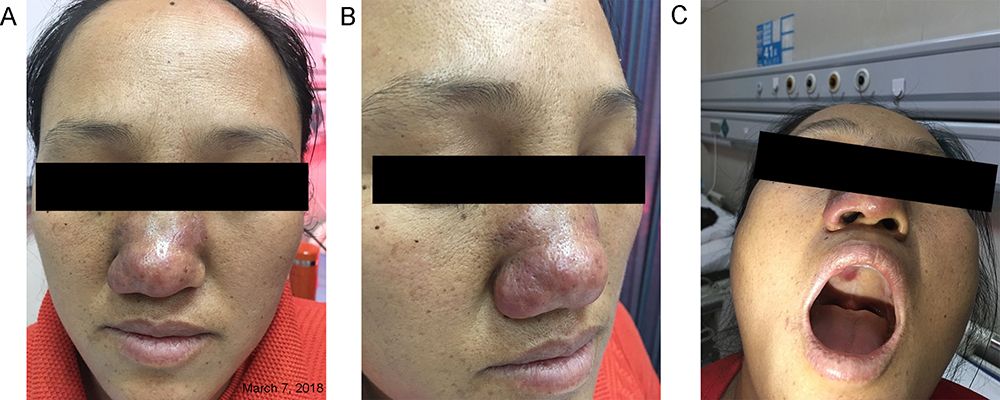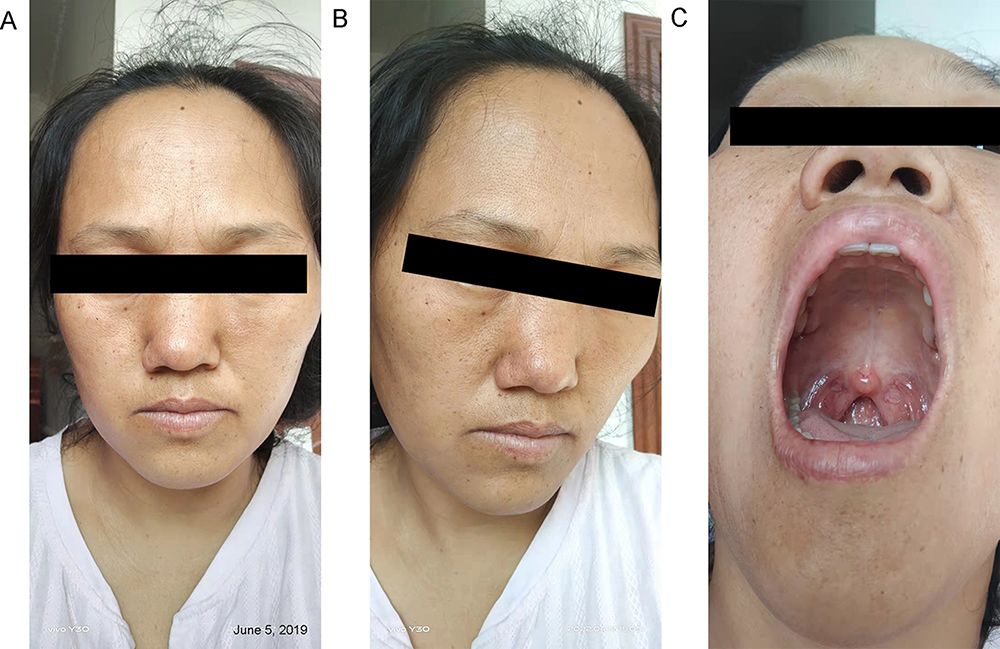- Case-Based Roundtable
- General Dermatology
- Eczema
- Chronic Hand Eczema
- Alopecia
- Aesthetics
- Vitiligo
- COVID-19
- Actinic Keratosis
- Precision Medicine and Biologics
- Rare Disease
- Wound Care
- Rosacea
- Psoriasis
- Psoriatic Arthritis
- Atopic Dermatitis
- Melasma
- NP and PA
- Skin Cancer
- Hidradenitis Suppurativa
- Drug Watch
- Pigmentary Disorders
- Acne
- Pediatric Dermatology
- Practice Management
- Prurigo Nodularis
- Buy-and-Bill
News
Article
Jessner’s Lymphocytic Infiltration of the Skin Mimicking Rosacea: A Rare Case Presentation
Author(s):
Chinese clinical researchers recently presented a unique case of JLIS manifesting as erythematous papules and infiltrative plaques on the nose and upper jaw, resembling rosacea.
Erythematous, infiltrating plaques on the patient’s nose and upper jaw presented on March 7, 2018. | Image Credit: Dovepress

Jessner’s Lymphocytic Infiltration of the Skin (JLIS) is a rare chronic condition that often mimics pseudo-T-cell lymphoma. Characterized by a benign CD8+ polyclonal reactive skin condition, JLIS predominantly features CD4+ T cell infiltration.1 Chinese clinical researchers recently presented and published a unique case of JLIS in a 35-year-old woman, manifesting as erythematous papules and infiltrative plaques on the nose and upper jaw, resembling rosacea.2
First discovered and diagnosed in 1953, JLIS presented clinical features resembling pseudo-T-cell lymphoma. Unlike pseudo-T-cell lymphoma, JLIS is non-clonal and benign. This case report presents an unusual manifestation of JLIS with CD4+ T cell predominance, challenging the conventional understanding of the disease.
Case Presentation
A 35-year-old Chinese woman presented with a 1-year history of erythematous papules and infiltrative plaques on her nose and upper jaw. Initially diagnosed with rosacea, the discovery of infiltrative plaques on the upper jaw prompted further investigation. Histopathological examination revealed dense perivascular lymphocytic infiltrates with a predominance of CD4+ T cells, confirming the diagnosis of JLIS.
Erythematous, infiltrating plaques changes had cleared completely by June 5, 2019 and has remained clear for 5 years. | Image Credit: Dovepress

Treatment and Outcome
The patient was treated with oral minocycline, resulting in a significant improvement after 4 weeks. The dosage was reduced after observing an 80% regression of skin lesions, and complete clearance was achieved after two months. No recurrence was observed during a 5-year follow-up period.
Discussion
JLIS presents as erythematous papules and plaques, primarily affecting the face, neck, and trunk. Differential diagnosis includes conditions such as lupus erythematosus, gyrate erythema, and cutaneous lymphoid hyperplasia. The current case presented with atypical features resembling rosacea, emphasizing the importance of comprehensive evaluation for accurate diagnosis.
Rosacea predominantly affects middle-aged individuals, with a higher incidence in women. Unlike rosacea, which can progress to severe nasal hypertrophy in men over 40, the current case lacked these features, aiding in the exclusion of rosacea as a diagnosis.
The etiology of JLIS remains unclear, with genetic factors, autoimmune mechanisms, and photosensitivity proposed as potential triggers. Certain medications and infections have also been associated with JLIS. Despite the uncertainty surrounding its etiology, JLIS responds to various treatment modalities, including topical agents, systemic therapies, and laser therapy.
This case highlights a rare presentation of JLIS closely mimicking rosacea, with additional atypical manifestations affecting the upper jaw. Oral minocycline proved to be a safe and effective treatment, leading to complete resolution without recurrence over a 5-year follow-up period. While JLIS remains a rare and poorly understood condition, this case emphasizes the importance of considering JLIS in the differential diagnosis of rosacea-like skin lesions and underscores the potential utility of Minocycline in its management. Further research is warranted to elucidate the pathogenesis and optimal treatment strategies for JLIS.
Looking for more insightful rosacea content?
Dermatology Times is highlighting a variety of resources and considerations for the condition as we recognize Rosacea Awareness Month. ICYMI, here are a few articles and quizzes shedding light on the latest rosacea treatment options and discoveries.
One study uncovered high levels of CGRP in patients with rosacea, with levels not affected by age, sex, BMI, and other factors.
QUIZ: Test Your Knowledge of Rosacea Etiology, Types, and Triggers
Click here to read more and answer our quiz questions in recognition of Rosacea Awareness Month.
Rosacea Awareness Month: Resources to Share With Your Patients
This Rosacea Awareness Month, we have compiled a list of resources for clinicians to share with their rosacea patients.
QUIZ: Test Your Knowledge of Rosacea Complications and Comorbidities
Test your knowledge of rosacea complications and comorbidities with this 5-question quiz.
Reviewing the Rosacea Pipeline: A Look at the Last 10 Years
In recognition of Rosacea Awareness Month, Dermatology Times is reviewing research and strides in rosacea treatment over the last decade.
References
- Williams CT, Harrington DW. Jessner Lymphocytic Infiltration of the Skin. 2023 Jul 24. In: StatPearls [Internet]. Treasure Island (FL): StatPearls Publishing; 2024 Jan–. PMID: 32965952.
- Li L, Wang Y, Gu H. Mimicking Rosacea? Jessner's Lymphocytic Infiltration of the Skin: a case report. Clin Cosmet Investig Dermatol. 2024 Apr 13;17:847-851. doi: 10.2147/CCID.S452008. PMID: 38633469; PMCID: PMC11022868.






